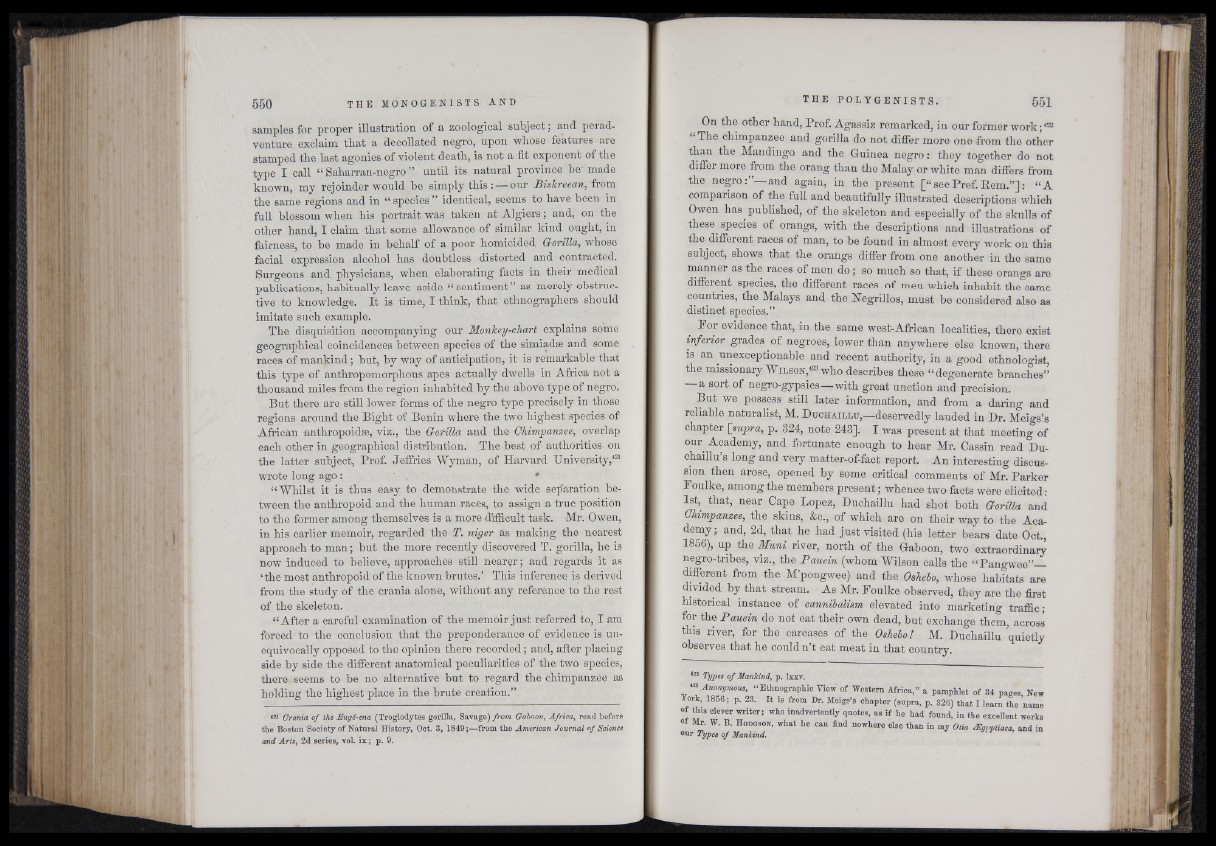
samples for proper illustriition of a zoological subject; and perad-
venture exclaim that a decollated negro, upon whose features are
stamped the last agonies of violent death, is not a fit exponent of the
type I call “ Saharran-negro” until its natural province he' made
known, my rejoinder would he simply this: — our Biskreean, from
the same regions and in “ species ” identical, seems to have been in
full blossom when his portrait was taken at Algiers; and, on the
other hand, I claim that some allowance of similar kind ought, in
fairness, to be made in behalf of a poor homicided G-orilla, whose
facial expression alcohol has doubtless distorted and contracted.
Surgeons and physicians, when elaborating facts in their medical
publications, habitually leave aside “ sentiment ” as merely obstructive
to knowledge. It is time, I think, that ethnographers should
imitate such example.
The disquisition accompanying our Monkey-chart explains some
geographical coincidences between species of the simiadse and some
races of mankind; but, by way of anticipation, it is remarkable that
this type of anthropomorphous apes actually dwells in Africa not a
thousand miles from the region inhabited by the above type of negro.
But there are still lower forms of the negro type precisely in those
regions around the Bight of Benin where the two highest species of
African -anthropoid®, viz., the Gorilla and the Chimpanzee, overlap
each other in geographical distribution. The best of authorities on
the latter subject, Prof. Jeffries Wyman, of Harvard University,421
wrote long ago: ' •
“Whilst it is thus easy to demonstrate the wide separation between
the anthropoid and the human races, to assign a true position
to the former among themselves is a more difficult task. -Mr. Owen,
in his earlier memoir, regarded the T. niger as making the nearest
approach to man; hut the more recently discovered T. gorilla, he is
now induced to believe, approaches still nearer; and regards it as
‘the most anthropoid of the known brutes.’ This inference is derived
from the study of the crania alone, without any reference to the rest
of the skeleton.
“ After a careful examination of the memoir just referred to, I am
forced to the conclusion that the preponderance of evidence is unequivocally
opposed to the opinion there recorded; and, after placing
side by side the different anatomical peculiarities of the two species,
there seems to he no alternative but to regard the chimpanzee as
holding the highest place in the brute creation.”
Crania of the Eugê-ena (Troglodytes gorilla, Savage) from Gaboon, Africa, read before
the Boston Society of Natural History, Oct. 3, 1849;—from the American Journal of Science
and Arts, 2d series, vol. ix ; p. 9.
On the other hand, Prof. Agassiz remarked, in our former work;422
“ The chimpanzee and gorilla do not differ more one from the other
than the Mandingo and the Guinea negro: they together do not
differ more from the orang than the Malay or white man differs from
the negro:”—and again, in the present [“ seePref.Rem.”] : “A
comparison of the full and beautifully illustrated descriptions which
Owen has published, of the skeleton and especially of the skulls of
these ^ species of orangs, with the descriptions and illustrations of
the different races of man, to he found in almost every work on this
subject, shows that the orangs differ from one another in the same
manner as the races of men do; so much so that, if these orangs are
different species, the different races of men which inhabit the same
countries, the Malays and the Negrillos, must he considered also as
distinct species.”
For evidence that, in the same west-African localities, there exist
inferior grades of negroes, lower than anywhere else known, there
is an unexceptionable and recent authority, in a good ethnologist,
the missionary W ilson,423 who describes these “ degenerate branches”
—a sort of negro-gypsies—with great unction and precision.
But we possess still later information, and from a daring and
reliable naturalist, M. D uch a il lu ,—deservedly lauded in Dr. Meigs’s
chapter [supra, p. 324, note 243]. I was present at that meeting of
our Academy, and fortunate enough to hear Mr. Cassin read Du-
chaillu’s long and very matter-of-fact report. An interesting discussion
then arose, opened by some critical comments of Mr. Parker
Poulke, among the members present; whence two facts were elicited:
1st, that, near Cape Lopez, Duchaillu had shot both Gorilla and
Chimpanzee, the skins, &c., of which are on their way to the Academy
; and, 2d, that he had just visited (his letter bears date Oct.,
1856), up the Muni river, north of the Gaboon, two extraordinary
negro-tribes, viz., the Pauein (whom Wilson calls the “Pangwee”__
different from the M’pongwee) and the Oshebo, whose habitats are
divided by that stream. As Mr. Poulke observed, they are the first
historical instance of cannibalism elevated into marketing traffic;
for the Pauein do not eat their own dead, but exchange them, across
this river, for the carcases of the Oshebo! M. Duchaillu quietly
observes that he couldn’t eat meat in that country.
422 Types of Mankind, p. Ixxv.
™ Anonymous, “ Ethnographic View of Western Africa,” a pamphlet of 34 pages, New
York, 1856; p. 23. It is from Dr. Meigs’s chapter (supra, p. 326) that I learn the ’name
o f this clever writer; who inadvertently quotes, as if he had found, in the excellent works
o f Mr. W. B. H o d g s o n , what he can find nowhere else than in my Otia <Eg,mtiaca, and in
our Types of Mankind.